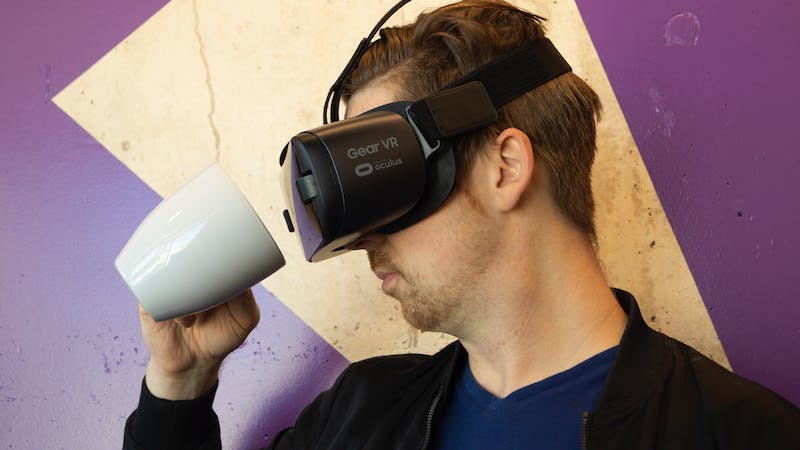What is an AR game?
An AR game, or Augmented Reality game, is a type of video game that blends the virtual world with the real world. Unlike traditional video games that are played entirely on a screen, AR games use the camera and sensors of a mobile device, such as a smartphone or tablet, to overlay digital elements onto the player’s view of the real world.
AR games typically involve interactive experiences where digital objects or characters appear in the real environment and interact with it. Players use their device’s screen to view the augmented reality, and they often need to physically move around and interact with the real-world surroundings to play the game.
Common examples of AR games include:
- Pokémon GO: This popular game allows players to explore the real world while capturing virtual Pokémon creatures that appear on their mobile device’s screen.
- Ingress: Ingress is an game that involves capturing and controlling virtual portals tied to real-world locations.
- Harry Potter: Wizards Unite: This game lets players immerse themselves in the Harry Potter universe by using AR to cast spells, discover magical creatures, and explore a wizarding world overlaid on the real world.
- Minecraft Earth: A mobile version of the popular sandbox game Minecraft, where players can build structures and interact with Minecraft elements in the real world using AR.
AR games offer a unique and immersive gaming experience by merging digital and physical realities. They often encourage outdoor exploration and social interaction, as players need to visit real-world locations to complete objectives or interact with other players. The popularity of AR games has grown significantly with advancements in mobile technology and the availability of AR-capable devices.

Technical analysis of AR games
A technical analysis of AR games involves examining the underlying technologies and components that make these games possible.
- Augmented Reality Technology: AR games rely on AR technology to superimpose digital objects, characters, or information onto the real world. This is achieved using the device’s camera and sensors to understand the user’s surroundings and position digital content within that environment.
- Computer Vision: Computer vision algorithms are essential for games. They enable the device to recognize and track objects and surfaces in the real world, allowing the AR elements to be anchored to specific locations or objects. This includes feature detection, image recognition, and motion tracking.
- Geolocation: Many games use GPS and geolocation data to place virtual objects or events at specific real-world locations. This enables location-based gameplay and encourages players to explore different places.
- Sensors: Smartphones and tablets have various sensors like accelerometers, gyroscopes, and magnetometers. These sensors are used to detect the device’s orientation and movement, which is crucial for providing a seamless AR experience.
- Graphics and Rendering: AR games require real-time 3D rendering capabilities to display virtual objects realistically within the real world. This involves rendering textures, lighting, and animations in a way that integrates seamlessly with the environment.
- Networking: Multiplayer games often require a network connection to synchronize the experiences of players in the same augmented environment. This involves real-time data exchange between devices to maintain consistency in the virtual world.
- User Interface (UI) Design: AR games need intuitive and user-friendly interfaces that allow players to interact with both the real world and virtual elements. This includes on-screen overlays, touch gestures, and spatial audio cues.
- Performance Optimization: AR games must run smoothly on a wide range of mobile devices with varying processing power and capabilities. Optimizing performance is crucial to ensure a lag-free and enjoyable experience.
- Data Processing: AR games involve significant data processing, from analyzing camera input to tracking objects and rendering graphics. Efficient algorithms and data handling are necessary to reduce latency and improve responsiveness.
- Security and Privacy: As games often collect location and sensor data, developers need to implement robust security measures to protect user information and privacy.
- Content Creation Tools: Developers use specialized tools and software to create 3D models, animations, and assets for AR games. These tools are essential for designing and integrating virtual content into the real world.
- Updates and Maintenance: AR games require ongoing maintenance and updates to ensure compatibility with new devices, operating systems, and evolving AR technologies.
Technical analysis of games involves evaluating how these components work together to create a seamless and immersive augmented reality experience. Developers must consider these factors to create engaging and technically sound games.
Famous AR game
There are several types of AR games that have gained popularity over the years, each offering a unique gaming experience.
- Location-Based Games: These games use GPS and geolocation data to place virtual objects or events at specific real-world locations. Players must physically travel to these locations to interact with the game. The most famous example is:
- Pokémon GO: Players explore the real world to find and capture virtual Pokémon creatures that appear on their mobile device’s screen.
- AR Adventure and Exploration Games: These games encourage players to explore the real world while interacting with AR elements and completing quests or challenges. Notable examples include:
- Harry Potter: Wizards Unite: Players become wizards and witches, casting spells and encountering magical creatures in the real world.
- Minecraft Earth: A mobile version of Minecraft where players can build structures and interact with Minecraft elements in the real world using AR.
- AR Social Games: These games promote social interaction by allowing players to team up or compete with friends in AR-enhanced environments. A well-known example is:
- Ghostbusters World: Players hunt and capture ghosts in the real world, collaborating with friends in multiplayer mode.
- Educational AR Games: AR can be a powerful tool for learning, and educational games aim to make learning more engaging. One of the famous educational games is:
- Zooscape: This game allows players to learn about animals and ecosystems by interacting with virtual animals in the real world.
- Puzzle and Strategy AR Games: These games combine AR elements with puzzle-solving or strategy gameplay. An example is:
- The Machines: A real-time strategy game where players control armies of machines in tabletop-sized battles on any flat surface.
- AR Sports and Fitness Games: These games encourage physical activity and exercise by incorporating AR elements into sports or fitness routines. A popular example is:
- Beat Saber: While primarily a virtual reality (VR) game, it has an AR mode that allows players to see the game world through their phone’s camera and interact with the beat-based gameplay.
- AR Escape Room Games: These games offer escape room experiences in augmented reality, challenging players to solve puzzles and unlock clues in their real surroundings. An example is:
- ARia’s Legacy: Players solve mysteries and puzzles in an immersive AR escape room adventure.




